9+ Sample Healthy Grocery List Templates
-
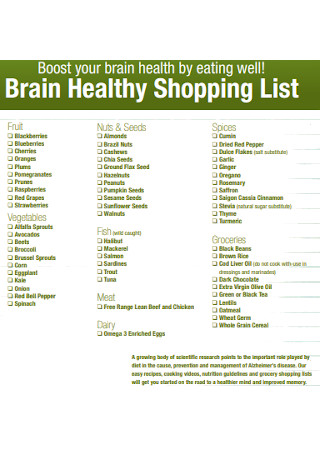
Brain Healthy Grocery List
download now -
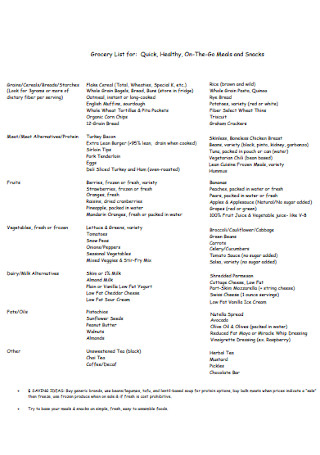
Healthy Snacks Grocery List
download now -
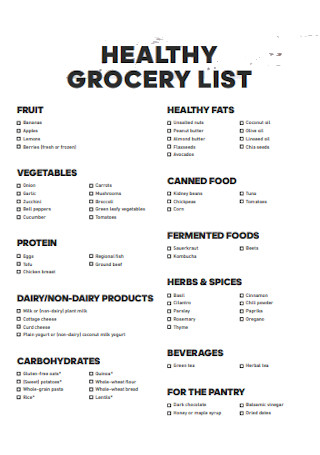
Sample Healthy Grocery List
download now -
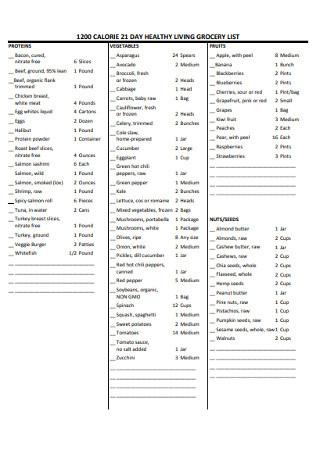
Healthy Living Grocery List
download now -

Heart Healthy Grocery List
download now -
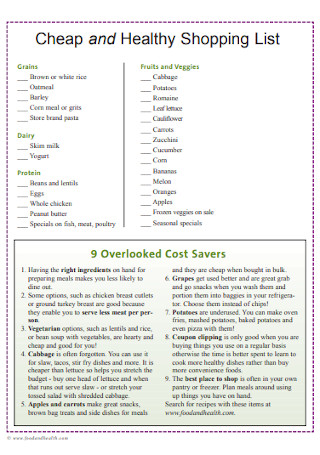
Cheap and Healthy Shopping List
download now -
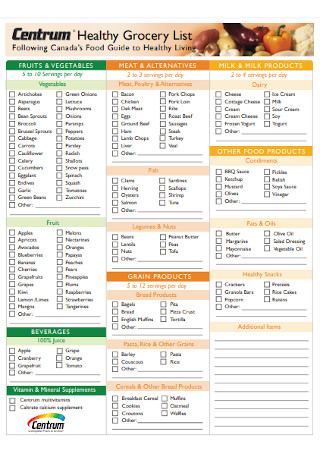
Healthy Grocery List Format
download now -
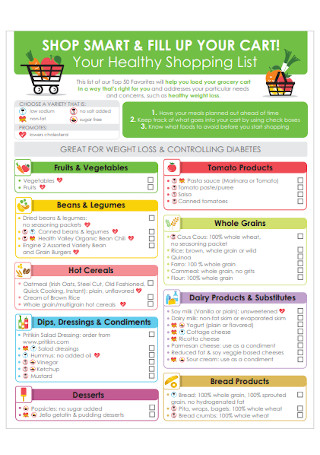
Healthy and Grocery Shopping List
download now -
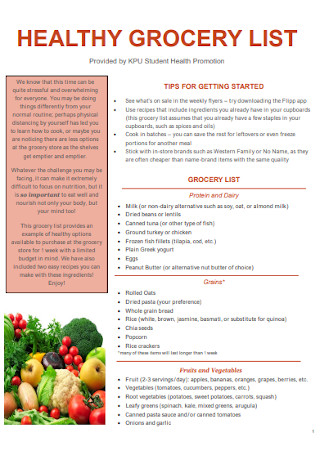
Healthy Student Grocery List
download now -
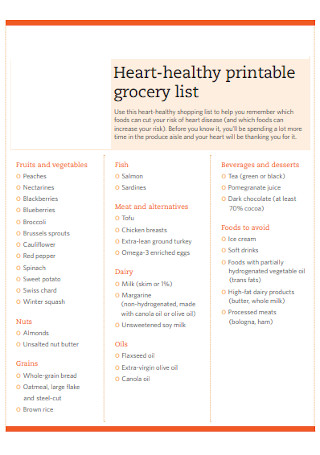
Printable Healthy Grocery List
download now
FREE Healthy Grocery List s to Download
9+ Sample Healthy Grocery List Templates
What Is a Healthy Grocery List?
The Basic Ingredients of a Healthy Grocery List
What Are the Main Categories for Healthy Grocery Lists?
How to Make a Healthy Grocery List
FAQs
What are the best healthy foods to eat?
What are examples of foods to never eat?
What are the essential factors for a well-balanced diet?
What Is a Healthy Grocery List?
Any wise buyer would be familiar with a grocery list. It is a comprehensive tool that documents what you have to purchase while grocery shopping. Meanwhile, a healthy grocery list refers to that same tool, except it focuses primarily on buying healthy food and other beneficial products. So instead of forgetting to buy certain items at the grocery store, you can prepare a healthy grocery list ahead. The process is simple—bring that shopping list and use it as your reference while buying at the store.
According to research, people who consider grocery shopping with a list and a healthy diet would more likely stay in a healthier weight.
Meanwhile, the National Public Radio (NPR) reported that 75% of Americans think they eat healthily but evidence shows the opposite.
Also, Shape tells us that the top 10 healthy foods to always shop for are lemons, broccoli, potatoes, dark chocolate, walnuts, salmon, avocados, garlic, beans, and spinach.
Why Are Healthy Grocery Lists Important?
A healthy grocery list is essential specifically for buying wisely. Expect this list to guide you in focusing only to get healthy foods at the grocery store. The thing is a lot of temptations are at different shops. An example is when some junk products are on sale. Or perhaps, there is a lot of options that can be overwhelming at the store that you forget what you are supposed to buy. So to combat your forgetfulness, prevent temptations, and ensure that you can save money by sticking to a plan, use healthy grocery lists.
It is also important to note that around 75% of Americans think they eat healthily. But based on evidence, the results are quite the opposite. Not everyone is actually on a healthy diet. Hence, these grocery lists are around to help you in sticking to a healthy diet, whether it involves gluten-free, low-carb, or a vegetarian lifestyle. You can also tailor the list according to your health goal in case you are planning for weight loss, muscle strength, and other goals. Nonetheless, everything will pay off if you do stick to the list.
The Basic Ingredients of a Healthy Grocery List
Yes, a healthy grocery list is important and beneficial. But what exactly can be found in such lists? Although people differ in terms of how they create their lists, there are some common elements to notice as well. And this leads us to determine the basic ingredients of a standard healthy grocery list.
What Are the Main Categories for Healthy Grocery Lists?
You already know that categorizing a healthy grocery list is part of the major elements that make up such a list. But what exactly are the necessary categories to add to your list? In this section, we outlined the main categories worth adding to your grocery list.
How to Make a Healthy Grocery List
Now for the main dish of this article, how do you exactly create a healthy grocery list? For starters, you do not have to start from the very beginning. See those sample templates above? That is all you need to craft a list. All templates are ready to edit, download, and print. And for a proper introduction on how to make that list excellently, just follow these steps:
Step 1: Set Your Health Goals
First things first, what are your health goals? Do not just storm off to the grocery store without even knowing what you are planning to achieve. Bear in mind that your plans will help you recognize what foods and substances you should consume for your body. Suppose you are aiming for weight loss. Expect to implement a low-carb diet and you would not simply add sugary foods to your grocery list. Also, a tip is to work with a nutritionist to receive the best recommendations on what to eat.
Step 2: List What You Need to Buy in a Draft
Once you are clear with your health goals, list down what you need to eat in a draft. Be sure every food or product you write is going to lead you to your goal, not hinder it. And the reason why you still need a draft is that mistakes are still welcome here. You will eventually edit and change some elements to what you listed afterward.
Step 3: Transfer the Details into a Template
After creating your draft, transfer what you wrote to a sample healthy grocery list template of your choice. This part is where you finalize what to buy at the grocery store. Allow our sample templates to guide you on how the format works and how to correct the list. But you can also customize every template according to your needs. Go for the best version that you want for this document.
Step 4: Insert and Arrange the Necessary Elements
We already discussed the ingredients that make up a standard healthy grocery list. As you recall, there are elements needed. Be sure to insert them one by one, from the title down to the notes section. Otherwise, your list might be incomplete. The most important element categories for your list. You can follow the categories discussed earlier, from the whole grains to the healthy snacks. But you can also do it differently like arranging the items from the most affordable item down to the most expensive. That way, you can prepare your budget and go for cheap options as well.
Step 5: Observe an Easy-to-Follow Structure
The last thing you want is a grocery list that is hard to understand and follow. Make it easy to follow instead. That means the list is user-friendly enough that you would know what to buy first until last and that you can really use it as an easy reference while shopping. You can add instructions anyway in case you would forget some considerations or if you are giving that list to someone else as a task list, like a college friend, family member, or partner. And once you are confident with the results, launch that list.
FAQs
What are the best healthy foods to eat?
According to Shape, the top 10 healthy foods to eat are lemons, broccoli, potatoes, walnuts, salmon, avocados, garlic, beans, spinach, and dark chocolates.
What are examples of foods to never eat?
Some of the foods that are harmful to health are sugary drinks, pizzas, fruit juices, cakes, french fries, sweetened cereals, and grilled food.
What are the essential factors for a well-balanced diet?
Generally, there are seven basic factors that are perfect for a balanced diet. They are protein, carbs, fat, fiber, minerals, vitamins, and water.
Nobody really takes pride in grocery shopping, but it is still very important to gather all your important items and supplies. And the same can be said with a grocery list where you should work on getting all the healthy foods and ingredients to promote better health or lifestyle. Thanks to our sample healthy grocery list templates, grocery shopping has never been made easier. You won’t have to lose focus on buying all the products needed at the store, especially those items that are crucial to benefiting your health. Download now!
